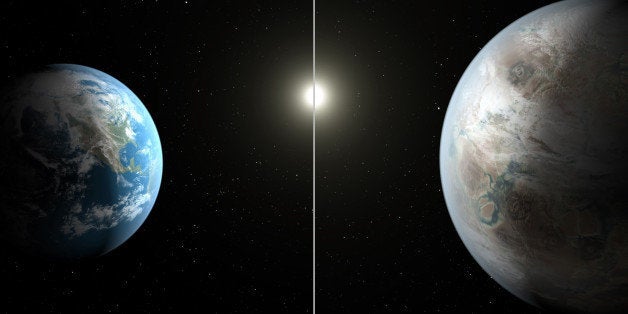
I was struck by a simple problem, among the many things I heard in these days about the discovery of planet Kepler 452b, now baptized as "cousin of the Earth." This may be due to a bias in my mind, which is automatically oriented towards finding discrepancies, or better unpredictable holes, in the ways the main announcement of a scientific discovery is made to the public.
First, from non-specialized radio speakers, I heard (twice) a sentence running as: "We have admired the beautiful pictures of the new planet," and I immediately realized how deceiving astronomical concepts are when their divulgation passes a number of times from one description to the following one. All the official public outreach sites I checked on the net (e.g. the NASA page, the Kepler mission Facebook page) make clear that the nice images illustrating the comparison between the Earth and the "cousin" Kepler 452b are plain "artist's conceptions" or "artistic views" of the planet, and not photos of any kind. Kepler 452b in fact is 1400 light years away!
A bit later on, I discovered that even a non-naif good friend of mine had fully conceived the idea that a space probe had reached the far-away solar system (and taken the images)!
She had not counted the time span necessary to do such a mission. Even disregarding the enormous energy necessary to power such space probe, and letting it travel at the velocity of the light (impossible claim), the probe would have taken 1400 years to arrive close to the planet and take the "beautiful pictures," and further 1400 years to send them back. So the mission should have begun with a launch 2800 years ago.
What was happening during the 9th century BC? Only Egyptians, Assyrians and Chinese people were civilized. Well, we can build fantasy tales about pyramids being launching pads for space probes... Let me stop here.
How can people get such a wrong understanding of what this discovery consists of?
The problem can be that, during our time, true images of the distant bodies of the solar system full of wonder and amazement our eyes. The latest were the incredible photos of comet Rosetta, and the details of Pluto's surface. For the inattentive listener or reader, then, it is not so easy to focus that our space probes can reachonly the close neighborhood of our Solar System, in times reasonable in terms of the human lifespan. Pluto's photos reached us in about five hours, which already is a long time, but is certainly not 1400 years!
So, not only there is no space probe close to the new planet, but it is important to clarify that we have no image of the planet itself taken by the Kepler satellite! The satellite can only monitor the luminosity of the star around which Kepler 452b orbits, and the planet detection consists in very tiny drops of its light, periodic with the period of the Kepler 452b year.
Kepler 452b host star is very similar to our Sun, so it has about the solar luminosity. Being 1400 light years away, it is a modest, insignificant star, of about 13th magnitude in the visible band of the spectrum -- stars are visible by eye, in a dark night, down to about sixth magnitude (notice that, the larger the magnitude, the lower is the luminosity). The Kepler satellite monitors the region where this and a lot of other stars are, in the Cygnus constellation, and measures their luminosity: If a planet transits across the disk of the star, its luminosity diminishes by a tiny fraction, and then comes back to the initial value when the planet is no longer projected on the surface. For instance, one part in a thousand is the drop in luminosity of our Sun, when Venus crosses its surface, seen from the Earth, as it happened in June 2012. So the idea is to catch the transits!
The principal investigator of the Kepler mission, a visionary, highly motivated space scientist named William Borucki, designed the project with the aim to look, mainly, at solar type stars and at orbital periods implying that the planet is at the right distance to reside in the "habitable zone," so around one year, like in the Solar System.
To reach this aim, the measurements must have these properties:
1) to be very precise, so that they can record drops of luminosity by about 1 part per 10 thousands;
2) to be very regular, with at least one measure every few hours, because the onset and end of the transit do not last for long;
3) to go on for very long time without interruptions, as a "detection" implies to have seen two or more of these tiny luminosity drops. The choices have been successful, with the detection of a few interesting candidates, including this latter one.
To conclude, the only "image" we have of the planet, is this tiny drop in luminosity of its host star, a drop repeated with a period of 385 days. Not much. All the other details given on the planet (it should be rocky, it can host water, and might have volcanic activity) are in part reasonable inferences, in part wishful thinking in the road to predict that the planet can host life.
Is this vision too disappointing? My view, as an astronomer, is that this is really a beautiful achievement. It costs money and a lot of work, sometimes exciting, sometimes hard and boring. But this is the way we learn more on our Universe.
The story of space mission dedicated to find extrasolar planets dates back a long time before Kepler, and is worth to be known in more detail.
